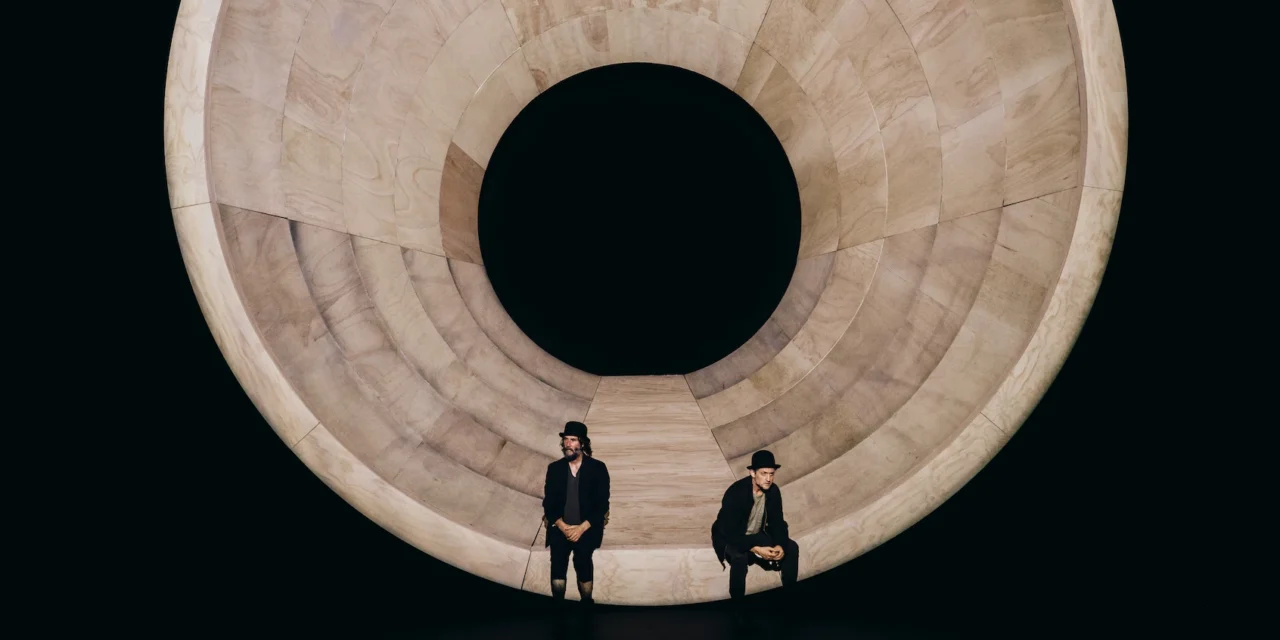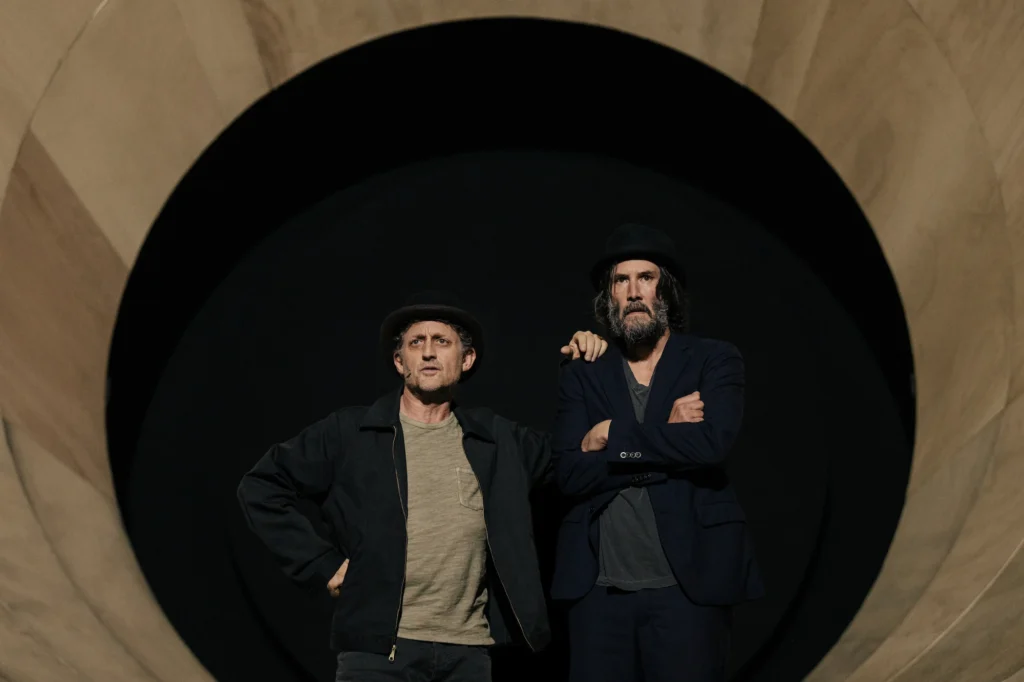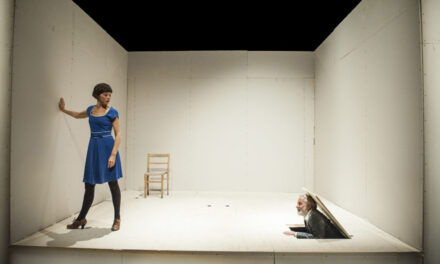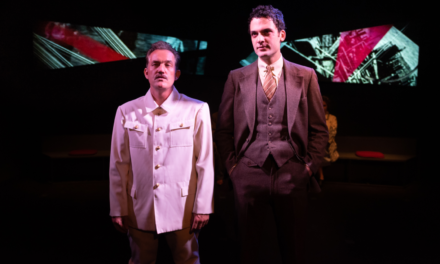Absurd as it may seem, Samuel Beckett’s Waiting for Godot, a demanding play about existential despair and cosmic futility first performed in 1953, has just opened on Broadway for the fifth time. Godot is the sole Beckett work that Broadway’s glitz-and-glamor-merchants have ever bet big money on, and three of those bets have occurred in the last sixteen years. Our era’s producers are evidently convinced that this play will finally unleash the long-dormant branding potential of modern drama’s most determined enemy of trivializing commercialism. And who can say they’re wrong? “People are bloody ignorant apes.”
The first two Broadway Godots happened before I was born, in 1956 and 1957. The third, Anthony Page’s 2009 version starring Bill Irwin and Nathan Lane, was excellent—sharp, sensitive, ruefully clawing, unforgettable. The fourth, Sean Mathias’s 2013 production with Patrick Stewart and Ian McKellen, a London transfer, was a travesty, with the irrepressibly patrician Stewart utterly unable to inhabit Beckett’s impoverished world. As I wrote in my review:
The only vaguely desperate or unapt quality to Stewart is his threadbare costume; all his professed inadequacy is really competence in disguise. Thus, even though McKellen is wonderful as Gogo—hilariously seedy and fascinatingly fidgety—Didi and Gogo’s plight of endless waiting wholly lacks danger and insecurity. It’s nothing but a flimsy platform for lame games whose innocuous triviality the audience confirms by crying “awww” after each one ends.
A very similar innocuousness pervades the new production directed by Jamie Lloyd, starring Keanu Reeves and Alex Winter—famous on- and offscreen buddies since their hit slacker comedy Bill & Ted’s Excellent Adventure (1989). Winter is a solid stage actor with good instincts, and he plays a perfectly adequate Didi. The irredeemably wooden Reeves, however, simply cannot handle a role like Gogo that requires constant credible give and take with a partner. He’s so stiff and tentative he comes off like a rookie actor walking through a workshop, chuffed just to have memorized his lines. My guess is that Lloyd, seeing how specious this was, decided to treat it as a virtue, which meant framing everything in the show as a winking, self-conscious choice. “Party on, dudes, we’re actors in a postmodern play!”
Dreadfully uninteresting, unoriginal, and inert, this approach falls into the same la-di-da triviality trap as Stewart and McKellen’s over-rehearsed gags, a sort of theatrical category error. And of course all the ogling stargazers in the audience who paid top dollar to see Reeves and Winter perform live couldn’t care less about that. Like their 2013 predecessors, they gush out saccharine and obsequious “awwws” whenever this celebrity pair hugs.
Among the winking choices presented as bold innovations here are (“Jamie Lloyd’s chic revival breaks all the rules,” boasts a sign hanging from the Hudson Theatre’s marquee): employing a huge, distracting, and impractical sculptural set that gives the actors almost no room to walk around and has no tree; eliminating props so that all the play’s physical business with carrots, turnips, rope, stool, picnic basket, chicken bones and more is either mimed or omitted; obstructing Lucky’s face with a Hannibal Lecter-style bite mask; and magnifying Pozzo theatrically so far beyond everyone else onstage that he seems like a refugee from another play.
The set by Soutra Gilmour—a large tapering blonde, megaphone-like tube that also resembles a marbleized water tunnel or the inside of a camera lens—is certainly striking as an installation piece, but its pertinence to Waiting for Godot is opaque. This set is obviously central to that rule-breaking claim, but the truth is, it’s novel only in the U.S. Equally unconventional (and far more effective) sets have been used in European Godots for decades.
The only walkable part of Gilmour’s construction is its central ramp, about four feet wide, so Reeves and Winter are forced to play most of the show on its downstage edge. They occasionally traipse upstage to pee, and a few times slide down the tube’s sides for fun. To refer to the tree, they point out at the mezzanine. The tube’s camera reference is reinforced by a giant black lens-cover affixed to the act curtain and loud shutter-click sounds bookending each act. What all these worldly references—suffused with media, technology, and celebrity—have to do with waiting, futility, or existential dread is a mystery.
For those steeped in comfort or luxury, the inconvenient truth is that Didi and Gogo have nothing—no recognizable world, no reliable identities, shelter, or source of food. Things like cameras, reputations, and style choices are irrelevant to them. Celebrities like Bert Lahr, Zero Mostel, Robin Williams and Steve Martin have played these roles movingly before, even incorporating their trademark routines and personas into them. But the reason those performances worked was that they were strikingly underpinned by fear. When Robin Williams as Gogo in 1988, for instance, broke briefly into a Rod Serling voice, or mimed pressing a TV remote as if to change the Beckett channel, or used a sheep skull as a movie clapper as if to stop the action, those antics were poignant because we all knew that this actor had been in some sense pleading desperately for love his whole career. Reeves and Winter have no inkling of that sort of vulnerability. They’ve added a single recognizable gag to their show—shredding air guitars momentarily after the line “Back to back like in the good old days”—but it carries no emotional weight. It comes off as a product placement, nothing less or more.
A lifetime of watching Beckett acting very closely has taught me that it is moving only when it manifestly costs the actor something. Any coasting or facile reliance on habit or convention makes the work recede into its verbiage and tedium and feel like a dry philosophical exercise.
Eliminating Godot’s props turns out to exacerbate this effect. Lloyd may have thought this choice was daring because it forced the audience to use its imagination, but we’re not really given a chance because the actors perfunctorily rush through all the mimed sequences. The spiritless miming furthermore deprives the cast of vital connections because objects are actually key to much silent eloquence in the play concerning love, avoidance, cruelty and much more. At two hours five minutes, this is the shortest Godot I’ve ever seen (it usually runs 2:30-2:40), and the lost time is almost all omitted physical business.
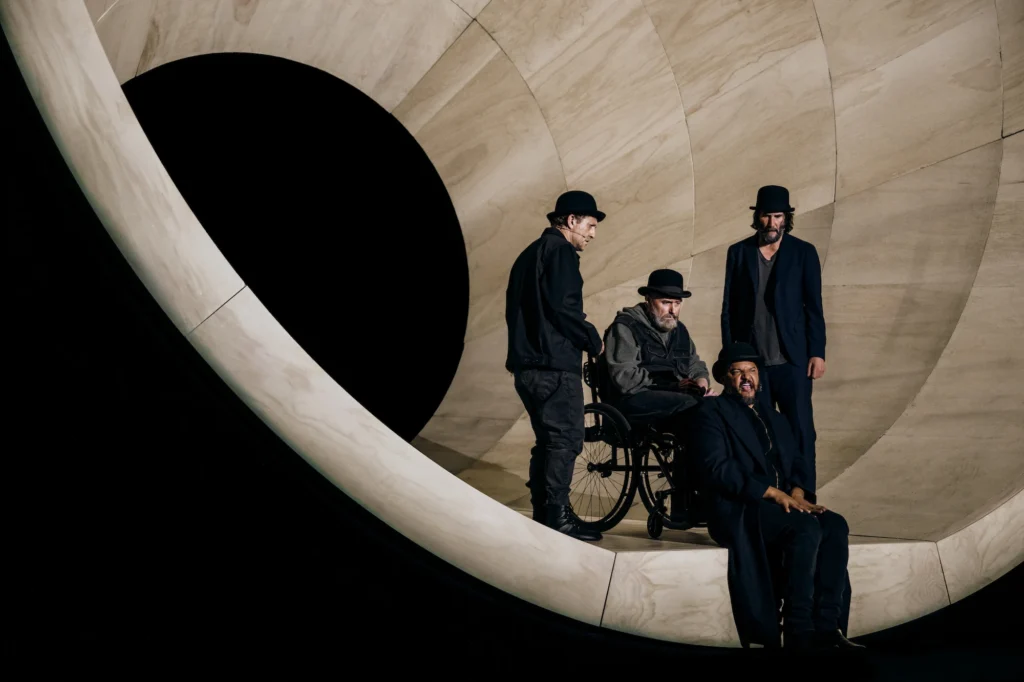
Left to right: Alex Winter (Vladimir), Michael Patrick Thornton (Lucky), Brandon J. Dirden (Pozzo), and Keanu Reeves (Estragon). Photo: Andy Henderson.
About this production’s Pozzo and Lucky, the less said, the better. The actors of these roles are both exceedingly talented and powerful, and each is differently wasted. Brandon Dirden has been much praised for his over-the-top bombastic, monstrously egomaniacal Pozzo, which is certainly an amusing vignette. Unfortunately, it has no relation to anything else in the show. Dirden never even develops a readable relationship to Michael Patrick Thornton’s Lucky, partly because Thornton is buried behind a silly mask for most of Act 1 and partly because the extensive servile prop actions that Beckett used to define this pair’s master-slave dynamic are all stripped away. Thornton (a vivid and magnetic presence in Lloyd’s A Doll’s House) uses a wheelchair and is consequently hamstrung by the narrowness of the set. He can’t turn or maneuver on his own and thus must rely on alienated Dirden for every major beat shift.
That is no doubt more than enough on this show-offy shell of a Godot. If you were contemplating shelling out $600 for orchestra seats, my advice is to think again and maybe treat yourself to Ragtime, Oratorio for Living Things, or Krapp’s Last Tape with Stephen Rea.
By Samuel Beckett
Directed by Jamie Lloyd
Hudson Theatre
This article appeared in TheatreMatters on October 13, 2025, and has been reposted with permission. To see the original article click here.
This post was written by the author in their personal capacity.The opinions expressed in this article are the author’s own and do not reflect the view of The Theatre Times, their staff or collaborators.
This post was written by Jonathan Kalb.
The views expressed here belong to the author and do not necessarily reflect our views and opinions.

